
Arethusa bulbosa, commonly called dragon's mouth orchid, is the only species in the orchid genus Arethusa. The genus is named after a naiad of Greek mythology. This monotypic genus is abbreviated Aret in trade journals.

Platanthera praeclara, known as the western prairie fringed orchid and the Great Plains white fringed orchid, is a rare and threatened species of orchid native to North America.
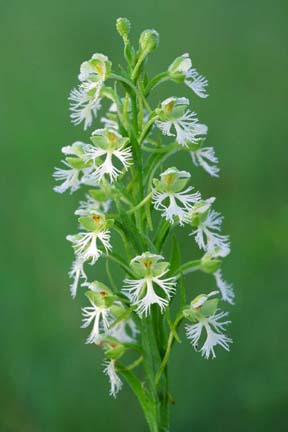
Platanthera leucophaea, commonly known as the prairie white fringed orchid or eastern prairie fringed orchid, is a rare species of orchid native to North America. It is a federally threatened species, protected since October 30, 1989 under the Endangered Species Act of 1973. In Canada, it has been listed endangered under Schedule 1 of the Species at Risk Act since 2005. In 2014, the International Union for Conservation of Nature assessed it as "least concern."

Liatris aspera is a perennial wildflower in the Asteraceae family that is found in central to eastern North America in habitats that range from mesic to dry prairie and dry savanna.

Polygaloides paucifolia, synonym Polygala paucifolia, known as gaywings or fringed polygala, is a perennial plant of the family Polygalaceae.

The genus Platanthera belongs to the subfamily Orchidoideae of the family Orchidaceae, and comprises about 150 species of orchids. The members of this genus, known as the butterfly orchids or fringed orchids, were previously included in the genus Orchis, which is a close relative. They are distributed throughout the temperate regions of the Northern Hemisphere. They are terrestrial and have tubercules.

Platanthera elegans is a species of orchid known by several common names, including elegant piperia, coast piperia, hillside rein orchid, and hillside bogorchid. This is a showy flowering plant native to western North America. It grows from a caudex tuber and sends up a thick stem just under a meter in maximum height. The stem is topped with a cylindrical spike inflorescence of densely packed flowers with curving white to greenish-yellow petals. Coastal individuals are noticeably thicker and have more flowers than those that grow further inland; it is uncertain if these are variants, subspecies, or even separate species. They are both currently treated as P. elegans. Other species of Plantanthera, notably the endangered species P. yadonii are quite similar in appearance to some populations of this species.

Cypripedium candidum, known as the small white lady's slipper or white lady's slipper, is a rare orchid of the genus Cypripedium. It is native to eastern North America across the northern United States and southern Canada.
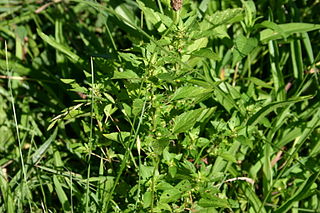
Acalypha rhomboidea is a plant in the spurge family, Euphorbiaceae.

Goodyera oblongifolia is a species of orchid known by the common names western rattlesnake plantain and giant rattlesnake plantain. It is native to much of North America, particularly in the mountains of the western United States and Canada, from Alaska to northern Mexico, as well as in the Great Lakes region, Maine, Quebec and the Canadian Maritime Provinces.
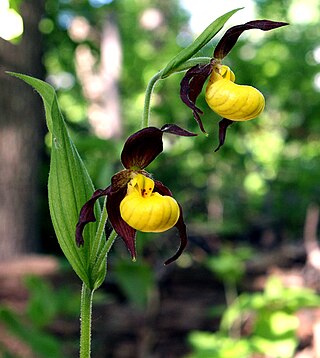
Cypripedium parviflorum, commonly known as yellow lady's slipper or moccasin flower, is a lady's slipper orchid native to North America. It is widespread, ranging from Alaska south to Arizona and Georgia. It grows in fens, wetlands, shorelines, and damp woodlands.

Helianthus grosseserratus, commonly known as sawtooth sunflower or thick-tooth sunflower, is a perennial sunflower in the family Asteraceae, with a large flowering head (inflorescence).

Symphyotrichum ascendens is a species of flowering plant in the family Asteraceae known by the common names western aster, long-leaved aster, and Rocky Mountain aster. Blooming July–September, it is native to western North America and can be found at elevations of 500–3,200 m (1,600–10,500 ft) in several habitats.

Platanthera psycodes, commonly called lesser purple fringed orchid or small purple-fringed orchid, is a species of orchid, genus Platanthera, occurring from eastern Canada to the east-central and northeastern United States. It is imperiled in Illinois, Tennessee, North Carolina, and Kentucky.
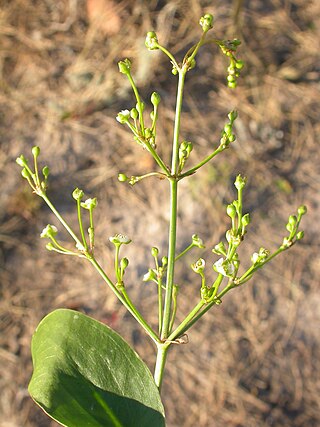
Alisma triviale, the northern water plantain, is a perennial semi-aquatic or aquatic plant in the water-plantain family (Alismataceae).

Platanthera obtusata, common name blunt-leaved orchid or small northern bog orchid, is a small species of orchid in the genus Platanthera. It widespread across much of the colder regions of the Northern Hemisphere, though rare in some parts of its range. Two subspecies are recognized:

Johnsonia pubescens, commonly called the pipe lily, is a grass-like plant in the family Asphodelaceae, subfamily Hemerocallidoideae, endemic to the south-west of Western Australia. As with others in the genus, it is distinguished by its minute flowers which are on the end of a spike and hidden by large, overlapping, papery bracts.

Platanthera dilatata, known as tall white bog orchid, bog candle, or boreal bog orchid is a species of orchid, a flowering plant in the family Orchidaceae, native to North America. It was first formally described in 1813 by Frederick Traugott Pursh as Orchis dilatata.
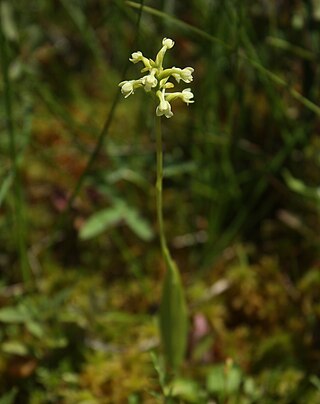
Platanthera clavellata, commonly known as the club-spur orchid or small green wood orchid, is a terrestrial orchid of North America.

Platanthera aquilonis, the northern green orchid or north wind bog orchid, is a species of self-fertilizing orchid native to the United States and Canada with a widespread distribution across the two countries.






















